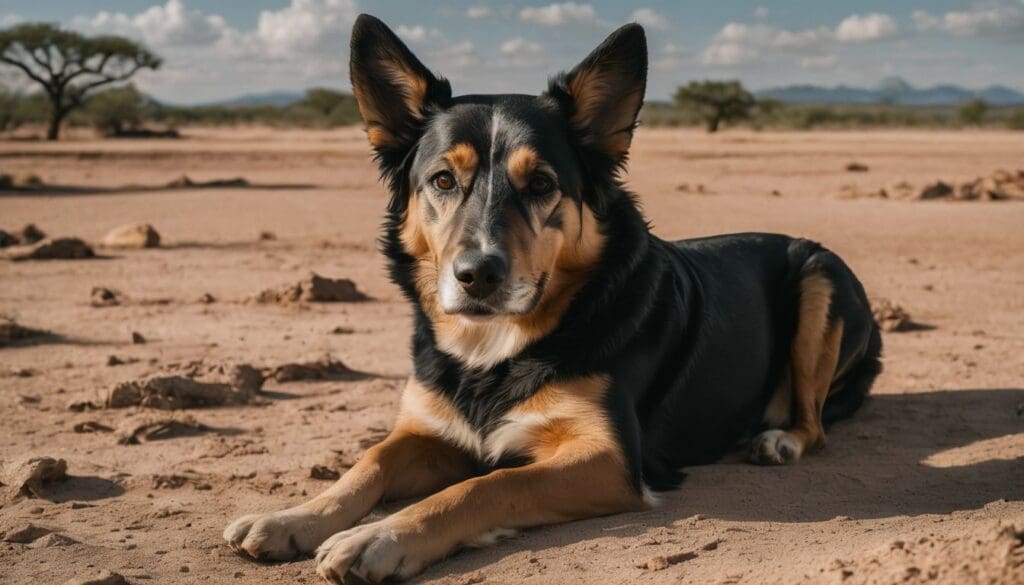Our pets aren’t just companions; they’re family members whose health can be hit hard by climate change. As the planet warms up, dogs and cats face new challenges, from overheating to heartworms spread by pesky mosquitoes thriving in the changing weather.
This article offers practical tips for protecting your furry friends from these growing threats and reducing their environmental paw-print at the same time. Keep reading to become a pet parent superhero in a warming world!
Key Takeaways
- Pets face serious health risks from climate change, including heatstroke and vector – borne diseases like Lyme disease.
- Environmental impacts of pet ownership contribute to climate change through greenhouse gas emissions from producing pet food and waste disposal.
- Limited exercise opportunities for pets due to extreme weather can lead to obesity and behavioural problems; indoor activities or shaded walks during cooler times may be necessary.
- Sustainable choices, such as eco-friendly pet supplies, locally produced food, and proper waste management practices help reduce pets’ environmental paws-print.
- Disaster preparedness plans should include provisions for pets to ensure their safety in emergencies, with accessible veterinary care crucial for all animals regardless of owner income.
Climate Change and Pet Health
Climate change can have a significant impact on pet health, leading to extreme weather events and the spread of infectious diseases. It also limits exercise opportunities for pets, affecting their overall well-being.
Extreme weather events
Extreme weather events, intensified by global warming, pose serious threats to pet health. Heatwaves can cause dehydration and heatstroke in pets left without adequate shelter or water.
Dogs especially suffer on hot days as they can only cool themselves by panting and sweating through their paws. Rapid temperature rises force pets to adapt quickly, which is not always possible for older or ill animals.
Flooding from storms disrupts the lives of many creatures, including household pets. Pets may lose their homes or face life-threatening situations when floods strike suddenly. Meanwhile, hurricanes and tornadoes put animals at risk of injury or separation from their families.
As such extreme weather occurrences become more common due to climate change, ensuring the safety and well-being of our furry friends becomes increasingly challenging.
Spread of infectious diseases
Climate change has resulted in the spread of infectious diseases among pets. As temperatures rise, parasites such as ticks and fleas thrive, leading to an increase in vector-borne diseases like Lyme disease and ehrlichiosis among animals.
Additionally, rising temperatures provide a conducive environment for the proliferation of bacteria and viruses that cause illnesses like Leptospirosis and Canine Distemper.
Pets are at risk from various infectious diseases due to climate change. Moreover, heightened awareness is crucial to protect their health amid changing environmental conditions without compromising overall well-being.
Limited exercise opportunities
Limited exercise opportunities for pets due to climate change can lead to various health issues, including obesity and behavioural problems. With rising temperatures, pet owners may find it challenging to take their animals outdoors for physical activity.
This lack of exercise can have detrimental effects on the overall well-being of pets, making it crucial for environmentally conscious individuals to seek alternative ways to keep their pets active and healthy despite these limitations.
Rising temperatures caused by global warming can limit outdoor activities for pets, affecting their physical fitness and mental stimulation. Consequently, pet owners must explore creative indoor exercises or utilise shaded areas during cooler times of the day to ensure that their animals receive adequate physical activity.
Pets’ Contribution to Climate Change
Pets’ Contribution to Climate Change includes the emission of greenhouse gases and the environmental impact of pet ownership. Understanding and addressing these contributions can help mitigate the overall impact of climate change on pet health.
Greenhouse gas emissions
Domestic animals, particularly dogs and cats, contribute to greenhouse gas emissions primarily through their dietary needs. The production of pet food often involves meat and animal by-products, which are resource-intensive and generate significant emissions.
| Pet Type | Food Source | Emission Details |
|---|---|---|
| Dogs | Meat-based diets | High emissions from livestock farming |
| Cats | Meat and fish | Similar high emissions, overfishing concerns |
| Small pets (e.g., rabbits, guinea pigs) | Plant-based diets | Lower emissions compared to carnivorous pets |
Considering the environmental impacts of pet ownership is crucial. Next, we will explore these impacts and how they extend beyond emissions.
Environmental impacts of pet ownership
Pet ownership significantly impacts the environment, contributing to greenhouse gas emissions and waste production. The carbon footprint of owning a pet can be substantial due to their dietary needs, as well as the resources required for producing toys, bedding, and other supplies.
Additionally, managing pet waste presents environmental challenges, with irresponsible disposal leading to pollution in waterways and soil contamination. As a result, promoting eco-friendly pet products and sustainable waste management is crucial in mitigating the environmental impact of pet ownership.
Moreover, pets also have implications on land use and wildlife conservation. Domesticated animals can disrupt natural ecosystems by predating on local wildlife or altering habitats through activities like digging and grazing.
Ways to Mitigate Climate Impact on Pet Health
Promoting sustainable pet food consumption, proper management of pet waste, and using eco-friendly pet supplies are all ways to reduce the environmental impact of pet ownership and mitigate the effects of climate change on pets.
Promoting sustainable pet food consumption
To promote sustainable pet food consumption, consider these tips:
- Choose pet food made from ethically sourced and sustainably produced ingredients to reduce the carbon footprint of your pet’s diet.
- Look for brands that use eco – friendly packaging, such as recyclable or biodegradable materials, to minimise environmental impact.
- Opt for locally produced pet food to support nearby agriculture and reduce transportation emissions.
- Consider alternative protein sources in your pet’s diet, such as insect-based or plant-based options, to lessen the environmental impact of meat production.
- Check for certifications like organic or fair trade labels on pet food products to ensure ethical and sustainable sourcing practices.
Proper management of pet waste
- Bag and bin it: Always pick up after your pet and dispose of their waste in designated bins.
- Composting: Use a dedicated composting system for pet waste, ensuring it is properly managed and does not contaminate surrounding soil or water sources.
- Pet waste stations: Utilise designated pet waste stations equipped with bags and disposal facilities when walking your pet in public areas.
- Safe disposal: Ensure that pet waste is disposed of thoughtfully to prevent contamination of water bodies, especially in areas close to rivers, lakes, or streams.
- Eco-friendly products: Opt for biodegradable or compostable poo bags to minimise the environmental impact of disposing of pet waste.
- Educate others: Spread awareness about the proper disposal of pet waste and its impact on the environment among fellow pet owners and within the community.
Using eco-friendly pet supplies
- Biodegradable poop bags made from plant-based materials, reducing plastic waste pollution.
- Natural, non – toxic grooming products that are free from harsh chemicals, benefiting both pets and the environment.
- Sustainable and organic pet bedding materials, such as hemp or bamboo, reducing the use of non-renewable resources.
- Eco – friendly toys made from recycled materials or sustainably sourced natural fibres, promoting a circular economy and reducing waste.
- Renewable and compostable cat litter options, minimising the environmental impact of disposing of used litter.
Maintaining the Human-Animal Bond in Disasters
Ensure disaster preparedness for pets and reduce inequity in the companion animal field.
Explore more about the impact of climate change on pet health and ways to mitigate it in our blog.
Disaster preparedness for pets
When preparing your pets for potential disasters, ensure you have a well-stocked emergency kit and ensure you have included the following items:
- Adequate food and water supply for at least three days.
- Identification tags and microchips to help locate lost pets.
- Medications and medical records stored in a waterproof container.
- Secure carriers or leashes to transport and control pets during an evacuation.
- Familiar comfort items such as toys or blankets to reduce stress in unfamiliar surroundings.
- Contact details for local animal shelters, veterinarians, and pet-friendly accommodations in case of evacuation.
- Emergency plan that includes designated caregivers for your pet if you are unable to care for them during a disaster.
Reducing inequity in the companion animal field
To reduce inequality in the companion animal field, it is essential to provide accessible veterinary care for all pet owners, regardless of their socioeconomic status. This can be achieved by offering low-cost or free vaccination clinics and spay/neuter programmes in underserved communities.
Additionally, promoting educational initiatives on responsible pet ownership and providing resources for affordable pet food and supplies can help bridge the gap in access to necessary pet care services.
Furthermore, advocating for policies that support animal welfare and address environmental changes affecting companion animals is crucial. Collaborating with local authorities and non-profit organisations to create disaster preparedness plans specifically tailored for pets can ensure that all animals are included in emergency rescue efforts during natural disasters.
Conclusion
In conclusion, climate change poses significant risks to pet health. Extreme weather events and the spread of infectious diseases are direct consequences of global warming. It is crucial for pet owners to take proactive steps in mitigating these impacts and promoting sustainable pet care practices.
By understanding the effects of climate change on pets and taking action, we can ensure a healthier future for our furry companions.
FAQs
1. How does climate change affect pets’ health?
Climate change brings more frequent extreme weather events and rising temperatures, which can lead to more cases of parasite-borne diseases affecting pet health.
2. What risks do pets face because of global warming?
Global warming increases the risk for pets as they might struggle with overheating and suffer from various climate-related diseases including those spread by ticks and fleas.
3. Can changes in the environment impact how I exercise my pet?
Yes, climate change can affect pet exercise opportunities due to harsher weather conditions, making it harder to ensure regular outdoor activities for your pet’s wellbeing.
4. Does my pet’s food consumption have an environmental impact?
Pet food consumption contributes to the overall carbon footprint of pet ownership, influencing environmental sustainability through resource use and production practices.
5. Should I adapt my pet care routine due to climate change?
As an owner, adapting your pet care approach is important in response to climate adaptation needs; this can include strategies for keeping your animal cool during hotter days or changing their diet according to new nutritional needs driven by environmental changes.





